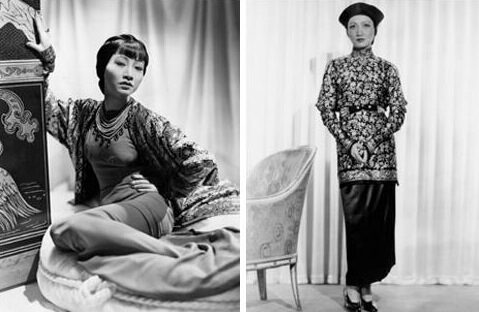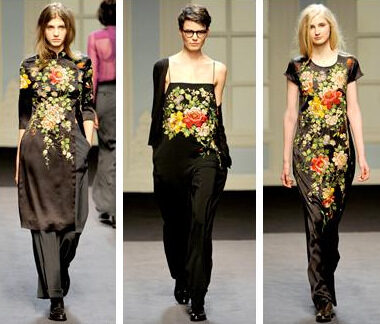Ready For My Close Up: Anna May Wong | Clothes on Film
Throughout summer it has been difficult to ignore the recent Chinoiserie trend in stores and magazines, kick-started by the opulent Louis Vuitton show in Paris and merged effortlessly into autumn by Paul Smith. Cheongsam collars and qipao slits aside, this new-found interest in the East may have been partly triggered by China’s growing appetite for high-end goods, which despite recent economic setbacks, has left Western luxury brands competing for a share of this very sizable market.
This obsession with the ‘Orient’ has also seen a proliferation of Asian models on catwalks and throughout editorial spreads, which has courted controversy for some publications and raises all manner of questions regarding ethnicity and standards of beauty. Whilst researching this trend it becomes impossible not to contemplate the first Chinese American star of cinema, Anna May Wong.

Anna May Wong was third generation ABC (American born Chinese) who grew up near LA’s Chinatown. In part due to her height (she was 5’ 7” – taller than a lot of the leading men at the time), she worked as an extra on films from a young age. In 1922 she landed her first leading role in one of the earliest colour feature films, The Toll of the Sea, and found fame playing a Mongol slave in The Thief of Bagdad (1924) opposite Douglas Fairbanks.
Disappointed by the lack of opportunity afforded her in Hollywood, Wong sailed for Europe in her late teens. Here the somewhat more progressive movie industries provided options for many stars that fell outside of the American system through reasons of race, artistic fulfilment or a combination of the two, such as Josephine Baker, Louise Brooks and Paul Robeson. It was in London that she made what many consider to be her crowing glory, Piccadilly (1929).

In Piccadilly, Anna May Wong plays Shosho, a dishwasher in a central London nightclub who has a penchant for dancing; she gets fired for distracting the other workers then is eventually re-hired to become the star. While beautiful, the film is something of a cultural mash-up, an exaggerated celebration of Eastern exoticism as seen through the rose-tinted lens of Hollywood.
The dance below is a pivotal moment in the film; Wong goes on stage unknown and comes off a star. Yet this has very little to do with Chinese culture. Choreographed by Wong herself, the piece is inspired by Thailand, and the costume is certainly reminiscent of traditional Thai dance (albeit far more skimpy), predominantly the pagoda shoulders and towering headdresses of the stylised Khon and the court dance Lakhon Nai, which in turn was a huge influence on the Royal Ballet of Cambodia. (More can be read on the cultural inaccuracies in this dance at Classical Iconoclast).
On her return to Hollywood, Wong found that roles throughout the 30’s ranged from passive, hard-done-by heroines (who often ended up dead) to prostitutes and ‘Dragon Lady’-style murderesses (who often ended up dead). Daughter of the Dragon (1931) epitomises this role; she plays the daughter of arch-villain Fu Manchu, out to avenge his death. The Japanese actor and early heartthrob Sessue Hayakawa also stars as the detective on her trail, making this the only film of Hollywood’s Golden Age to star two ethnically East Asian actors.

In 1932, Wong made the second film that, together with Piccadilly, would form the bulk of her legacy. Shanghai Express was directed by Josef von Sternberg and starred Marlene Dietrich as notorious prostitute Shanghai Lily with Anna May Wong in a smaller yet pivotal role as Hui Fei – a slightly less notorious prostitute – on their dangerous journey across China during the Civil War that began in 1927. The film is typically lavish von Sternberg, shot with such incredible chiaroscuro lighting that it won a well-deserved Oscar for its cinematography. And as with any von Sternberg picture it is a true Marlene-fest; while Wong mixes knowing glances with strangely demure (considering her profession) pyjama suits and cheongsam-collared nightwear, Dietrich is as extravagant as you could hope for from any Travis Banton-designed, Depression-era fantasy: a luminescent mirage in satin and cockerel feathers.

The truth is, Hollywood often did not know what to do with Anna May Wong. She regularly received top billing but pay and roles were disproportionate to star status and she often missed out on leading Asian roles to white actresses, a practice that was as old as film itself: when the first film version of Madame Butterfly was made in 1915, Cio-Cio-San was played by ‘America’s Sweetheart’ Mary Pickford.
Ethnically Chinese but acculturated American, Wong often found herself in a state of flux symptomatic of Homi Bhabha’s hybridity – too Chinese for contemporary American audiences yet too American for Chinese. Her relationship with China was no easier; the Chinese press labelled her a traitor many times for her clichéd roles as prostitutes. Wong’s ‘Americanisation’ was actively encouraged by Hollywood, where studio moguls wanted her to operate as both a thoroughly modern Flapper who wore the latest fashions and danced the Charleston, but who could also symbolise a distinct Otherness in the characters she played.

Her clothing off-screen was employed as a way to win favour with American audiences. She was something of a sartorial heavyweight; her 5’7” stature and slim frame gave her the air of a supermodel when other Hollywood clotheshorses like Gloria Swanson and Joan Crawford were listed as anything from 4’11” to 5’5”. Her impact was so great that the Mayfair Mannequin Society of New York even voted her the “world’s best dressed woman” in 1934. Her long limbs, as well as the mix of American and Chinese influences are evidenced in an early Technicolor short, Hollywood Party (1937), where Wong models cheongsams that she acquired on a trip to China:
Wong also performed as other ‘exotic’ races during her early time in Hollywood, managing to be cast as Arabian, Inuit and Native American, among others. Although this cross-cultural casting was common at the time, it was particularly widespread through the practice of ‘yellowface’ – white actors playing Asian roles. This fed into a long history of racial tension, especially on the West Coast of America.
Much anti-Chinese legislation was passed in the early 20th century, and the so-called ‘yellow peril’ had been a perceived threat since the late 1800s. Anti-miscegenation laws in many states prevented inter-racial relationships, and as such inter-racial intimacy between actors was forbidden from being portrayed onscreen, even if they were playing characters of the same race; even in Piccadilly, produced in London where less racial tension existed, censors were forced to cut the scene in which Wong and her (white) co-star kissed. Tellingly her character ends up dead for transgressing race boundaries.

The practice of ‘yellowface’ was acceptable throughout the film industry for much longer than ‘blackface’. The look was generally attained by applying spirit gum and elastic bands to give the eyes a higher slant and has achieved some truly horrendous results. The list of actors who have performed in ‘yellowface’ is shocking – besides the hideous but well known portrayal of the Japanese landlord by Mickey Rooney in Breakfast at Tiffany’s (1961), other actors (from a long list) who chose to ‘yellow up’ for roles include Katharine Hepburn, Fred Astaire, John Wayne and Marlon Brando.


A notable exception to this caricature in early Hollywood is Richard Barthelmess’s pacifist scholar in DW Griffith’s Broken Blossoms or The Yellow Man and The Girl (1919). The portrayal is comparatively sympathetic overall, if patronising and verging on inhuman, albeit with clichés such as opium addiction in tow. However, considering it is directed by Griffith – who was not exactly a master of race relations if you examine at his back catalogue which includes infamous epic Birth of a Nation (1915) – the storyline is certainly more progressive than some of his output.

In the late 60’s, the practice of ‘yellowface’ thankfully fell out of favour (although David Carradine unfortunately continued to play a Shaolin monk throughout the 70′s in the TV series Kung Fu). Which makes it all the more surprising that it should be brought back into the spotlight by none other than Karl Lagerfeld. The Chanel Paris/Shanghai Pre-Fall 2010 collection promo, written and directed by Lagerfeld, is a very odd dream sequence of a film, featuring Coco Chanel trotting through periods of China’s recent history.
According to WWD, Lagerfeld said of the concept, “Coco Chanel never came to China, so they imagine the trip she never made, a fantasy of her coming to Shanghai in the Thirties and Forties and during the Cultural Revolution.” He is so keen to continually stress the complete lack of basis in reality that the film ends with male model Baptiste Giabiconi made up as Emperor of Imperial China uttering the immortally profound line, “Historical details are not important, because all this is just a dream.”

This bizarre resurrection of ‘yellowface’ practices sees long-time Lagerfeld collaborator Amanda Harlech play not only Wallis Simpson but also the last Empress Dowager of Imperial China, while Freja Beha and Baptiste Giabiconi play Mao-era comrades in utilitarian suits and Japanese model Tao Okamoto plays Anna May Wong. When questioned on these anachronistic methods, Lagerfeld claimed he was referencing old films, saying “it is an homage to Europeans trying to look Chinese.” Admittedly the spirit gum is replaced by tres chic eyeliner, but does this really make it an acceptable practice even in the fantasy realm of fashion imagery? Does it make it any better that (German) Marlene Dietrich is played by (American) Heidi Mount, or that the young (French) Coco Chanel is played by (Lithuanian) Edita Vilkeviciute?


And what of Anna May Wong? After hosting a few TV shows in the 50’s’ she died a somewhat untimely death in 1961 at the age of 56. Yet she left behind a rich stylistic legacy that fuses East and West and is readily plundered by fashion designers and image makers today, fuelled also by the economic dominance and vast history of China.


If you are still not sated, we advise you to visit the Glamour of the Gods exhibition at the National Portrait Gallery where an ethereal image of Anna by Eugene Robert Richee from 1924 is on display.
By Amber Butchart, author of Theatre of Fashion and half of Broken Hearts DJ duo.
You can watch movies online including Anna May Wong in Shanghai Express at LOVEFiLM.com.
© 2011, Contributor.
Related Posts: